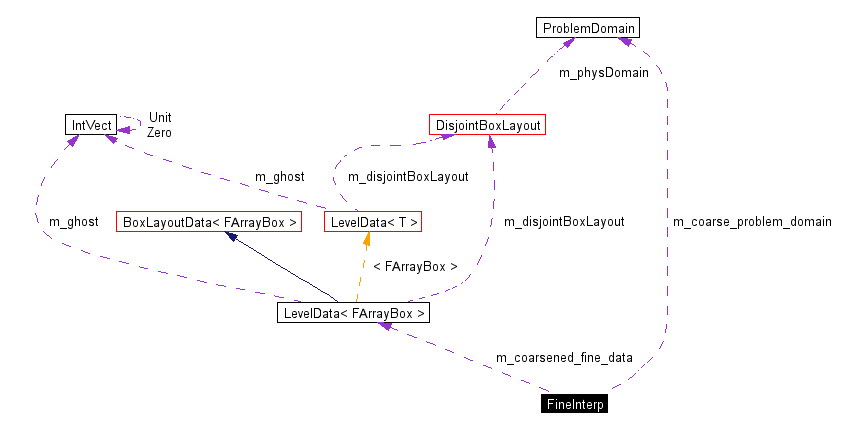
#include <FineInterp.H>
Collaboration diagram for FineInterp:

Public Member Functions | |
| FineInterp () | |
| ~FineInterp () | |
| FineInterp (const DisjointBoxLayout &a_fine_domain, const int &a_numcomps, const int &a_ref_ratio, const Box &a_fine_problem_domain) | |
| FineInterp (const DisjointBoxLayout &a_fine_domain, const int &a_numcomps, const int &a_ref_ratio, const ProblemDomain &a_fine_problem_domain) | |
| void | define (const DisjointBoxLayout &a_fine_domain, const int &a_numcomps, const int &a_ref_ratio, const Box &a_fine_problem_domain) |
| void | define (const DisjointBoxLayout &a_fine_domain, const int &a_numcomps, const int &a_ref_ratio, const ProblemDomain &a_fine_problem_domain) |
| bool | isDefined () const |
| void | interpToFine (LevelData< FArrayBox > &a_fine_data, const LevelData< FArrayBox > &a_coarse_data) |
Protected Member Functions | |
| void | interpGridData (BaseFab< Real > &a_fine, const BaseFab< Real > &a_coarse, const Box &a_coarsened_fine_box, int a_ref_ratio) const |
Protected Attributes | |
| bool | is_defined |
| int | m_ref_ratio |
| LevelData< FArrayBox > | m_coarsened_fine_data |
| ProblemDomain | m_coarse_problem_domain |
This class replaces data at a fine level of refinement with data interpolated from a coarser level of refinement. Interpolation is piecewise bi(tri)linear, with van Leer slopes if there is room for the stencil, with lower-order slopes if there isn't. See the design document.
|
|
Default constructor. User must subsequently call define(). |
|
|
Destructor. |
|
||||||||||||||||||||
|
Defining constructor. Constructs a valid object. Equivalent to default construction followed by define(). { Arguments:}\ a_fine_domain (not modified): the fine level domain.\ a_numcomps (not modified): the number of components.\ a_ref_ratio (not modified): the refinement ratio.\ a_fine_problem_domain (not modified): problem domain at the fine level.\ |
|
||||||||||||||||||||
|
Defining constructor. Constructs a valid object. Equivalent to default construction followed by define(). { Arguments:}\ a_fine_domain (not modified): the fine level domain.\ a_numcomps (not modified): the number of components.\ a_ref_ratio (not modified): the refinement ratio.\ a_fine_problem_domain (not modified): problem domain at the fine level.\ |
|
||||||||||||||||||||
|
Defines this object. Existing information is overriden. { Arguments:}\ a_fine_domain (not modified): the fine level domain.\ a_numcomps (not modified): the number of components.\ a_ref_ratio (not modified): the refinement ratio.\ a_fine_problem_domain (not modified): problem domain at the fine level.\ { This:}\ ---This object is modified.--- |
|
||||||||||||||||||||
|
Defines this object. Existing information is overriden. { Arguments:}\ a_fine_domain (not modified): the fine level domain.\ a_numcomps (not modified): the number of components.\ a_ref_ratio (not modified): the refinement ratio.\ a_fine_problem_domain (not modified): problem domain at the fine level.\ { This:}\ ---This object is modified.--- |
|
||||||||||||||||||||
|
|
|
||||||||||||
|
Replaces a_fine_data with data interpolated from a_coarse_data. It is an error to call if not this->isDefined(). The domain of a_fine_data should be the same as the fine domain specified in the most recent call to define(). It is expected that the coarse and fine level's domains are properly nested. Both a_coarse_data and a_fine_data should have the same number of components specified in the most recent call to define(). { Arguments:}\ a_fine_data (modified): fine data. \ a_coarse_data (not modified): coarse data. \ { This:}\ Well, it's complicated. As far as the user is concerned, this object is not modified. See the design document if you care for details. |
|
|
Returns true if this object was created with the defining constructor or if define() has been called. { This:}\ This object is not modified. |
|
|
|
|
|
|
|
|
|
|
|
|
 1.3.2
1.3.2